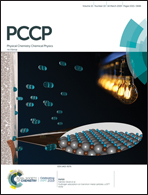Cations brought together by hydrogen bonds: the protonated pyridine–boronic acid dimer explained†
Abstract
According to the Cambridge Structural Database, protonated pyridine–boronic acid dimers exist in the solid phase, apparently defying repulsive coulombic forces. In order to understand why these cation–cation systems are stable, we carried out M06-2X/6-311++G(3df,2pd) electronic structure calculations and used a set of computational tools (energy partitioning, topology of the electron density and electric field maps). The behavior of the charged dimers was compared with the corresponding neutral systems, and the effect of counterions (Br− and BF4−) and the solvent (PCM model) on the binding energies has been considered. In the gas-phase, the charged dimers present positive binding energies but are local minima, with a barrier (16–19 kJ mol−1) preventing dissociation. Once the environment is included via solvent effects or counterions, the binding energies become negative; remarkably, the strength of the interaction is very similar in both neutral and charged systems when a polar solvent is considered. Essentially, all methods used evidence that the intermolecular region where the HBs take place is very similar for both neutral and charged dimers. The energy partitioning explains that repulsion and electrostatic terms are compensated by the desolvation and exchange terms in polar solvents, thus giving stability to the charged dimer.



 Please wait while we load your content...
Please wait while we load your content...